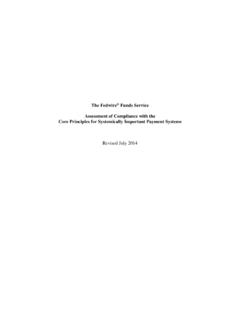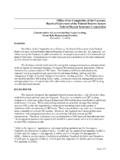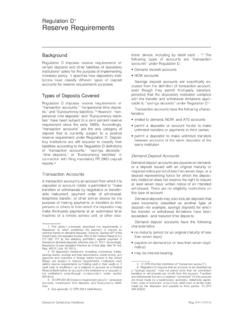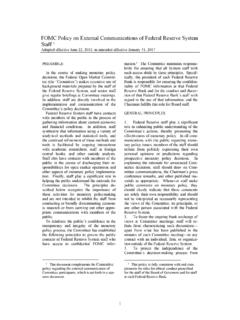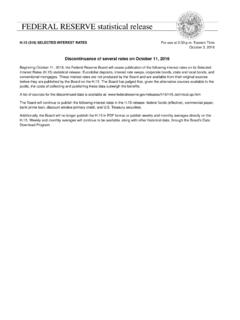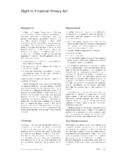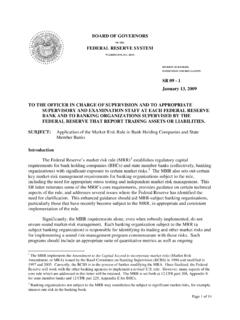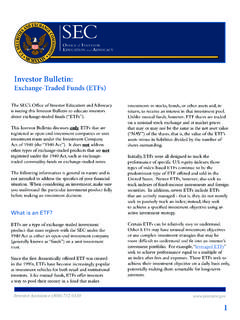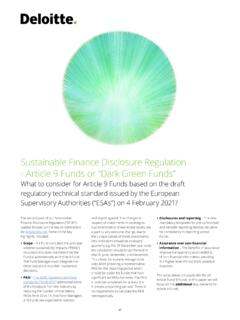Transcription of Regulation E Electronic Fund Transfer Act
1 Regulation EElectronic fund Transfer ActThe Electronic fund Transfer Act (EFTA) (15 seq.) of 1978 is intended to protectindividual consumers engaging in Electronic fundtransfers (EFTs) and remittance transfers. Theseservices include transfers through automated teller machines(ATMs); point-of-sale (POS) terminals; automated clearinghouse (ACH) systems; telephone bill-payment plans in which periodic orrecurring transfers are contemplated; remote banking programs; and remittance EFTA is implemented through Regulation E,which includes official 2009, the Federal Reserve Board (Board)amended Regulation E to prohibit institutions fromcharging overdraft fees for ATM and one-time debitcard transactions, unless the consumer opts in oraffirmatively consents to the institution s overdraftservices (74 Fed.)
2 Reg. 59033 (Nov. 17, 2009) and75 Fed. Reg. 31665 (June 4, 2010)). The Boardalso amended Regulation E to restrict fees andexpiration dates on gift cards and to require thatgift card terms be stated clearly (75 Fed. (April 1, 2010)).1 The Dodd Frank Wall Street Reform and Con-sumer Protection Act (Dodd Frank Act) transferredrulemaking authority under the EFTA from theBoard of Governors of the Federal Reserve Systemto the Consumer Financial Protection Bureau(CFPB).2,3 The Dodd Frank Act also amended theEFTA and created a new system of consumerprotections for remittance transfers sent by con-sumers in the United States to individuals andbusinesses in foreign countries. In December2011, the CFPB restated the Board s implementingRegulation E at 12 CFR Part 1005 (76 Fed.
3 (December 27, 2011). In February 2012, theCFPB added subpart B (Requirements for Remit-tance Transfers) to Regulation E to implement thenew remittance protections set forth in the Dodd Frank Act (77 Fed. Reg. 6194) (February 7, 2012),effective on February 7, July 2012, theCFPB amended the February 2012 rule to effectcertain technical corrections primarily related toformatting of the model forms in the rule. In August2012, the CFPB again amended the February 2012rule to modify the definition of remittance transferprovider. The August amendment also revisedseveral aspects of the rule regarding remittancetransfers that are scheduled before the date oftransfer, including preauthorized remittance trans-fers (77 Fed. Reg. 50244) (August 20, 2012). InJanuary 2013, the rule s February 21, 2013,effective date was delayed pending finalization of aproposal to address three specific issues in therule.
4 In May 2013, the CFPB finalized the proposal,which modified the disclosure requirements forcertain fees and foreign taxes, revised someaspects of the error resolution requirements, andestablished a new effective date of October 28,2013 (78 Fed. Reg. 30661) (May 22, 2013).Information in this narrative is provided forsubpart A and subpart B in the order listed that the order, particularly as it relates tosubpart A, does not strictly follow the order of theregulatory text. For ease of use by the examiner,however, the examination procedures and check-list follow the order of the AI. Scope and Key Definitions (12 CFR , , , )II. Disclosures (12 CFR , , , , , )III. Electronic Transaction Overdraft Service OptIn (12 CFR )IV. Issuance of Access Devices (12 CFR , )V.
5 Consumer Liability and Error Resolution (12 CFR , )VI. Receipts and Periodic Statements (12 , )VII. Gift Cards (12 CFR )1. The Board also implemented a legislative extension of timefor complying with the gift card disclosure requirements untilJanuary 31, 2011. 75 Fed. Reg. 50683 (August 17, 2010).2. Dodd Frank Act 1002(12)(C), 1024(b)-(c), and 1025(b)-(c); 12 5481(12)(C), 5514(b)-(c), and 5515(b)-(c).Section 1029 of the Dodd Frank Act generally excludes from thistransfer of authority, subject to certain exceptions, any rulemakingauthority over a motor vehicle dealer that is predominantlyengaged in the sale and servicing of motor vehicles, the leasingand servicing of motor vehicles, or both. The Transfer of authorityalso did not include section 920 of EFTA, which concerns debitcard interchange fees charged to merchants.
6 Section 920 of EFTAis implemented by Board regulations at 12 CFR Part 235. Section920 is not addressed here or in the accompanying examinationprocedures and The agency responsible for supervising and enforcingcompliance with Regulation E will depend on the person subjectto the EFTA ( , for financial institutions, jurisdiction will dependon the size and charter of the institution).4. The amendment designated 12 CFR through subpart Compliance HandbookReg. E 1 (11/13)VIII. Other Requirements (12 CFR , , )IX. Relation to Other Laws (12 CFR )Subpart BRequirements for remittance transfersX. Remittance Transfer Definitions (12 )XI. Disclosures (12 CFR )XII. Estimates (12 CFR )XIII. Procedures for Resolving Errors (12 )XIV. Procedures for Cancellation and Refund ofRemittance Transfers (12 CFR )XV.
7 Acts of Agents (12 CFR )XVI. Transfers Scheduled Before the Date ofTransfer (12 CFR )Sections Applicable to BothSubpart A and Subpart BXVII. PreemptionXVIII. Administrative Enforcement and Record Re-tention (12 CFR )XIX. Miscellaneous (EFTA provisions not reflectedin Regulation E)SUBPART AI. ScopeKey Definitions 12 CFR deviceis a card, code, or other means ofaccess to a consumer s account or a combinationof these used by the consumer to initiate devices include debit cards, personalidentification numbers (PINs), telephone transferand telephone bill payment codes, and othermeans to initiate an EFT to or from a consumeraccount (12 CFR (a)(1) and 12 CFR Part1005, Supp. I, Comment 2(a)-1).Access devices do not include either of thefollowing: magnetic tape or other devices used internally bya financial institution to initiate Electronic trans-fers a check or draft used to capture the MICR(Magnetic Ink Character Recognition) encodingor routing, account, and serial numbers to initiatea one-time ACH debit (Comments 2(a)-1 and2(a)-2)Accepted accessdevice is an access devicethat a consumer requests and receives, signs, or uses (or autho-rizes another to use) to Transfer money betweenaccounts or to obtain money, property, orservices requests to be validated even if it was issued onan unsolicited basis receives as a renewal or substitute for anaccepted access device from either the financialinstitution that initially issued the device or asuccessor (12 CFR (a)(2))Accountincludes the following.
8 Checking, savings, or other consumer assetaccounts held by a financial institution (directly orindirectly), including certain club accounts, es-tablished primarily for personal, family, or house-hold purposes payroll card account, established through anemployer (directly or indirectly), to which EFTs ofthe consumer s wages, salary, or other employeecompensation (such as commissions), are madeon a recurring basis. The payroll card accountcan be operated or managed by the employer, athird-party processor, a depository institution, orany other person. All transactions involving thetransfer of funds to or from a payroll card accountare covered by the Regulation (12 CFR (b)(2) and Comment 2(b)-2).An account does not include: an account held by a financial institution under abona fide trust agreement an occasional or incidental credit balance in acredit plan profit-sharing and pension accounts establishedunder a bona fide trust agreement escrow accounts such as for payments of realestate taxes, insurance premiums, or completionof repairs accounts for purchasing savings bonds (12 CFR (b)(3) and Comment 2(b)-3)Apayroll card accountdoes not include a cardused solely to disburse incentive-based payments(other than commissions when they represent theprimary means through which a consumer ispaid) that are unlikely to be a consumer s primarysource of salary or other compensation.
9 Solely to make disbursements unrelated to com-pensation, such as petty cash reimbursements ortravel per diem payments; or in isolated instances to which an employertypically does not make recurring paymentsElectronic fund Transfer Act2 (11/13) Reg. EConsumer Compliance Handbook(Comment 2(b)-2).Activitymeans any action that results in anincrease or decrease of the funds underlying acertificate or card, other than the imposition of afee, or an adjustment due to an error or a reversalof a prior transaction (12 CFR (a)(7)).ATM operatoris any person that operates anATM at which a consumer initiates an EFT or abalance inquiry and that does not hold the accountto or from which the Transfer is made or about whichthe inquiry is made (12 CFR (a)).Dormancy fee and inactivity feemean a fee fornon-use of or inactivity on a gift certificate, store giftcard, or general-use prepaid card (12 CFR (a)(5)).
10 Electronic check conversion (ECK) transactionsare transactions where a check, draft, or similarpaper instrument is used as a source of informationto initiate a one-time Electronic fund Transfer from aconsumer s account. The consumer must authorizethe Transfer (12 CFR (b)(2)) Electronic fund Transfer (EFT)is a Transfer offunds initiated through an Electronic terminal,telephone, computer (including online banking) ormagnetic tape for the purpose of ordering, instruct-ing, or authorizing a financial institution to debit orcredit a consumer s account. EFTs include, but arenot limited to, point-of-sale (POS) transfers; auto-mated teller machine (ATM) transfers; direct depos-its or withdrawals of funds; transfers initiated bytelephone; and transfers resulting from debit cardtransactions, whether or not initiated through anelectronic terminal (12 CFR (b)).
